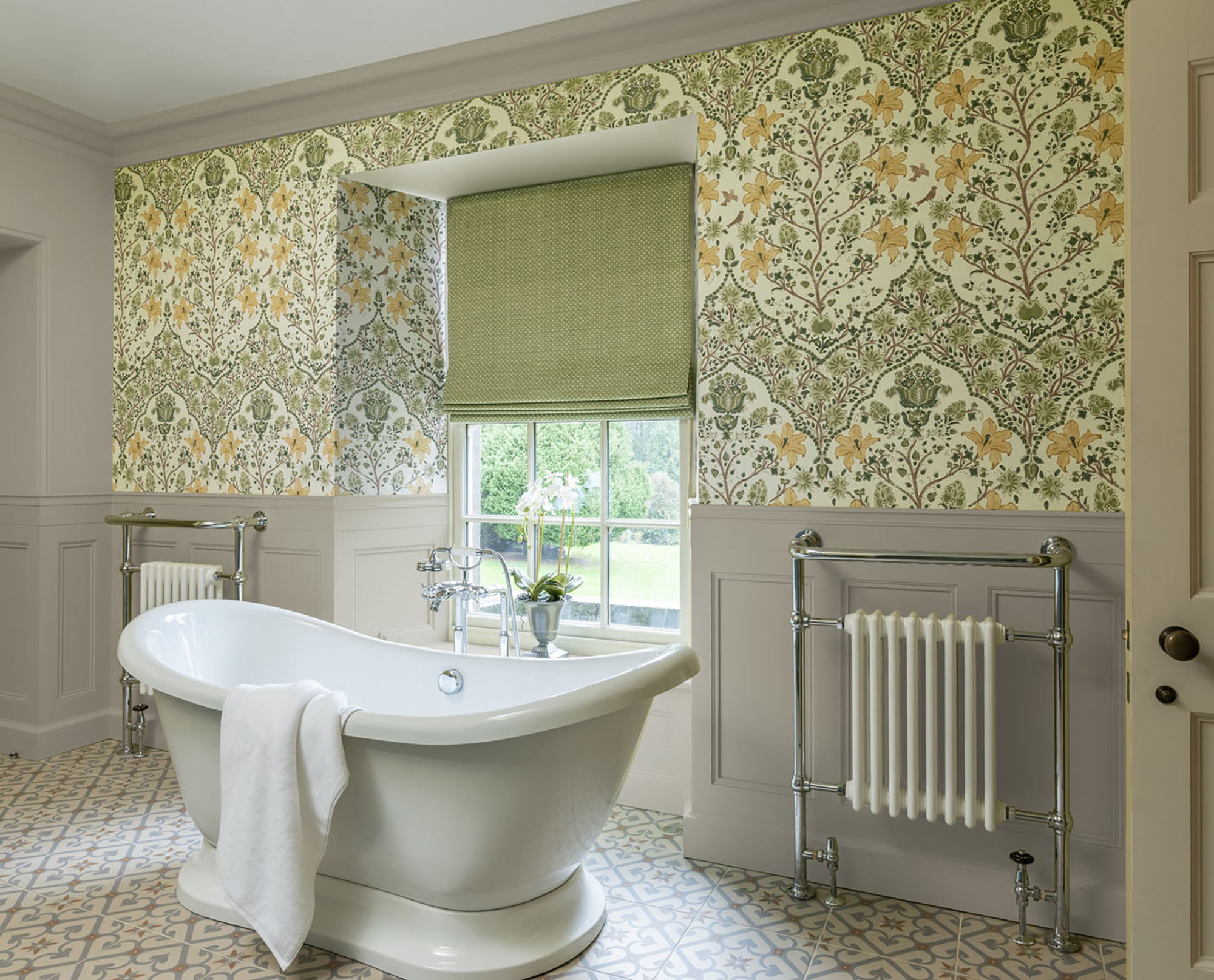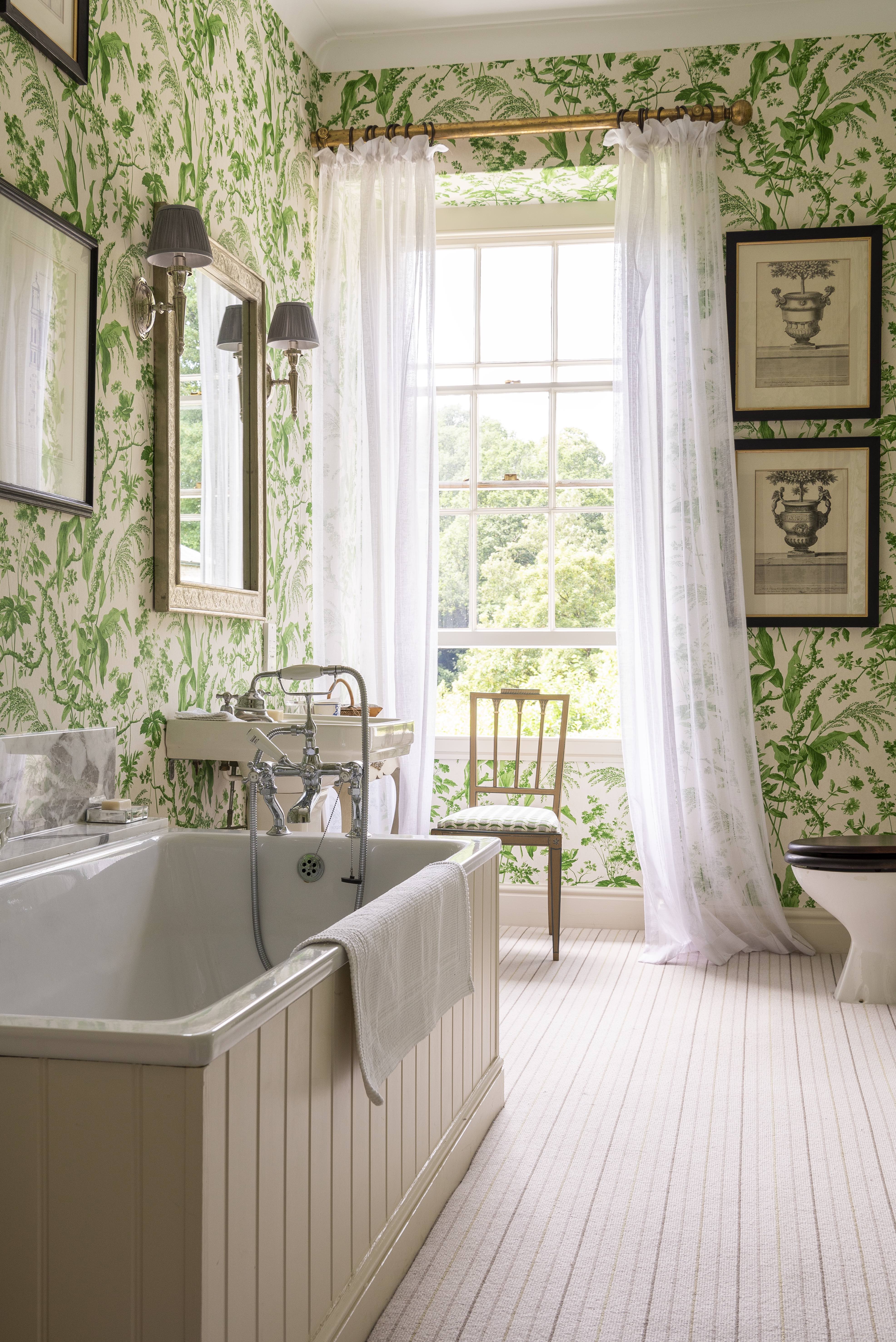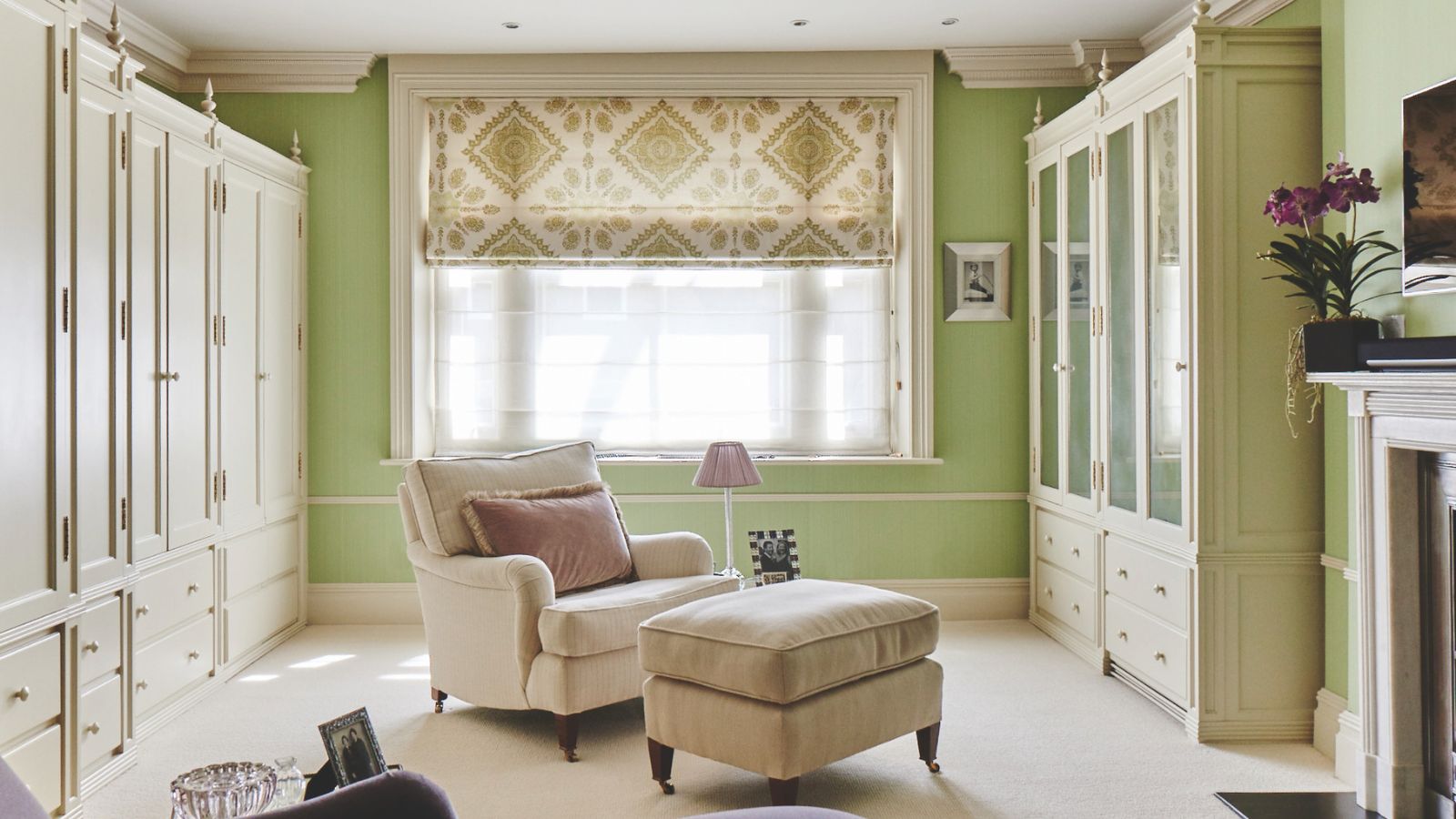How to wallpaper around a window – expert advice for achieving a smart finish
Wallpapering around a window can be daunting but we’ve got your back with a DIY-friendly expert guide


Our guide on how to wallpaper around a window will help you master this fiddly maneuver with ease so that you get the smart finish you want, whether you are DIYing or asking someone else to do the job for you.
While you may have graduated from removing wallpaper to the basics of how to wallpaper an uninterrupted wall, our guide is designed to take those skills up a level to wallpapering a full room.
Once you have learned how to wallpaper around a window, you’ll be able to get so much more creative with wallpaper ideas. Furthermore, wallpapering around doorways, fireplaces and even into alcoves is a very similar process, so those new skills can be applied to other wallpapering challenges.
How to wallpaper around a window

Professional decorators will likely use a far more complex technique involving splicing and overlapping – our version is pared back for keen DIY-ers, but the results are top rate.
Measuring for wallpaper accurately is crucial then make the type of wallpaper you buy your number one priority. If this is your first attempt at wallpapering around a window, we’d recommend buying paste-the-wall wallpaper, not paste-the-paper.
‘Applying paste to the wall is the best approach as it prevents the wallpaper from being weakened with moisture or incurring any accidental fold marks. Applying paste to the wall also eradicates the need for large surface spaces or a wallpapering table to apply the paste to flat rolls of wallpaper,’ explains Emma Coles, Senior Stylist at Sanderson Design Group.
The step-by-step guide below will demonstrate just how easy it is to wallpaper around a window.
You will need:
- Dust sheets/drop cloths
- Steps
- Paperhanging brush
- Tape measure or steel rule
- Pencil
- Plumb bob and line or laser level
- Sharp scissors
- Cutting knife with snap-off blades
- Trim edge/straight edge
- Seam roller (optional)
- Paste bucket
- Water bucket with sponge (for cleaning off any stray paste)
- Paste brush or roller
1. Find the perfect starting point
Establishing the best place to apply your first strip is one of the key wallpapering tips. ‘When wallpapering around a window you need to ensure you hang the paper with enough overlap left to wrap into the recess,’ says James Greenwood, Paint & Wallpaper expert at Graham & Brown. ‘If your window is a particular focal point of the room, then it will be easiest to start here, working from the left to right of the window.’
Wallpapering away from the natural light coming through a window will also help reduce the visibility of any minor overlaps between subsequent strips of wallpaper. ‘As most rooms are not perfectly square, there will be a pattern mismatch somewhere. Think about the best place to lose the pattern, most times it is behind a door,’ adds Gareth Hayfield, Head of Research and Technical Development at Farrow & Ball.
2. Overlap the window
Use the width of your wallpaper and a tape measure to find the best position in relation to the window for your first drop. For example, if your wallpaper is 20in wide and your window recess is 8in deep, you should hang your first piece around 4 to 5in to the left of the window, allowing an inch or so tolerance for trimming at the window frame. Increase the trimming tolerance if your window recesses/walls are particularly uneven, in a period cottage for instance.
Then use a plumb bob and line or laser level to mark where your first panel of wallpaper will go. Cut this first panel at least six inches longer than the height of the wall to avoid manhandling excessive amounts of wallpaper.
Lightly paste the wall and into the window recess, overlapping with paste by about 13⁄16 in on either side of where the wallpaper should go. Then line up your first panel of wallpaper and slide it onto the wall, using your hands and a wallpaper brush to smooth out any creases or air bubbles.
3. Make your first cuts
This first wallpaper panel should be overhanging your window recess by about 8.5in. Feel through the paper to find the corner of the recess at the top and made a light indent. Take your sharp scissors and cut horizontally from the right edge of the paper to this indent in alignment with the top of the window recess. Do the same at the bottom. Your overhang should then fold right into the window recess, butting up to the window frame. Again, gently smooth out any creases or air bubbles.
Next, grab your straight edge and cutting knife and use it to trim vertically where the wallpaper meets window frame.
‘The secret is a straight edge and a very sharp blade. I use Olfa Japanese blades as they are sharp enough to cut through wet paper without buckling or tearing it,’ says Gareth Hayfield, Head of Research and Technical Development at Farrow & Ball.
If the window sill protrudes from the wall below the window, you may also need to cut out a thin rectangle so the wallpaper fits snugly around it. It helps to press the wallpaper against the sill to make an outline in the paper that you can use as a guide when cutting.
Finally, trim your first wallpaper panel at the top and bottom of the wall. Use your straight edge and cutting blade to trim off the excess. Some people prefer to use the back of their scissors to gently score a line at the point where wall meets ceiling or cornice (or skirting board at the bottom) then gently pull back the paper before cutting across the scored line with scissors. Use the brush to smooth the wallpaper back into place.
4. Continue with your next panels
Cut your next piece of wallpaper – which will go to the right of the first panel, above your window. Make it long enough to span from the ceiling above the window, to the top of the window recess and then into the recess, again allowing a little extra tolerance for trimming at both top and bottom.
Take care to ensure the pattern on this second panel aligns with the pattern on the first panel before you cut it from the roll. Hang the panel, butting neatly up to the first panel to the left, above the window, trimming at the top and where the paper meets the window frame. Use a seam roller, if you have one, to ensure secure adhesion where the panels join.
Carry on in the same manner below the window sill, again matching up patterns, and repeat until you reach the other end of your window recess.
5. Complete the window
With luck, the last panel to go into the right-hand window recess will have enough overhang to fold right into the recess in the same way as you did on the left. If not, simply cut a wallpaper strip a little wider than the gap you need to fill, matching the pattern, paste it on and trim any excess.
Now you have finished wallpapering around the window, you can continue with full length panels until you meet your next obstacle! ‘Before you install any curtain poles or blinds, make sure the wallpaper is completely set and dry. Allow at least a day, ideally two, otherwise you may risk the wallpaper ripping,’ says Jamie Watkins, founder of Divine Savages.
How do I wallpaper into a deep window reveal?
‘Wallpapering into a deep window reveal can often be daunting to those who are working with wallpaper for the first time. However, it isn’t as difficult as it initially appears. Simply measure a roll of wallpaper to understand where it will meet the reveal. Note, this may change where the wallpaper is hung from to begin with,’ says Emma Coles, Senior Stylist at Sanderson Design Group.
‘Once the first sheet has been laid, the second sheet should be placed alongside it to match up the pattern. When the paper has been smoothed out, the wallpaper can be cut with a sharp knife at the top portion of the window frame edge. On the edges of the reveal, the wallpaper should be cut at the top corners before being folded inwards so that the pattern continues into the window reveal.’
How easy it is to wallpaper around a window?
If you can wallpaper a wall, then you can definitely wallpaper around a window as well as learning to wallpaper a corner. If you have never wallpapered before, we’d recommend practicing on a wall without windows first; a feature wall is ideal.
‘Wallpapering around a window just takes patience, and the right tools. A sharp craft knife with plenty of snap-off blades is essential and will allow you to cut neat lines without tearing the paper. We also like to use a smoothing trim guide tool when hanging our wallpapers to achieve professional cuts into the window recess,’ says Jamie Watkins, founder of Divine Savages.
Take your time and don’t rush the project. It helps to buy plenty of wallpaper (and don't go too expensive) so if you get a cut or pattern match majorly wrong, you can pull it off and try again. There’s nothing more stressful than not having enough spare wallpaper to accommodate rookie errors.
Sign up to the Homes & Gardens newsletter
Design expertise in your inbox – from inspiring decorating ideas and beautiful celebrity homes to practical gardening advice and shopping round-ups.
Linda graduated from university with a First in Journalism, Film and Broadcasting. Her career began on a trade title for the kitchen and bathroom industry, and she has worked for Homes & Gardens, and sister-brands Livingetc, Country Homes & Interiors and Ideal Home, since 2006, covering interiors topics, though kitchens and bathrooms are her specialism.
-
 7 expert-approved painting hacks to minimize clean up – to make an already exhausting task easier
7 expert-approved painting hacks to minimize clean up – to make an already exhausting task easierAvoid a backbreaking clean-up after your next painting project with advice from the professionals
By Chiana Dickson
-
 Gwyneth Paltrow's quiet luxury kitchen is so beautiful, we almost overlooked her ultra-smart cabinets – they make the use of 'every inch' of storage space
Gwyneth Paltrow's quiet luxury kitchen is so beautiful, we almost overlooked her ultra-smart cabinets – they make the use of 'every inch' of storage spaceThe Goop founder makes use of dead space in her kitchen with customized cabinetry that reaches to the ceiling, providing ample storage
By Hannah Ziegler
-
 7 dorm room organizing rules for less clutter and more space
7 dorm room organizing rules for less clutter and more spaceExperts offer their top tips for creating a well-organized dorm room, no matter the size, space, or layout.
By Ashley Chalmers
-
 How to maximize storage in a small or shared dorm room, according to pro organizers
How to maximize storage in a small or shared dorm room, according to pro organizersFind out all the hidden storage zones you might never have noticed
By Ashley Chalmers